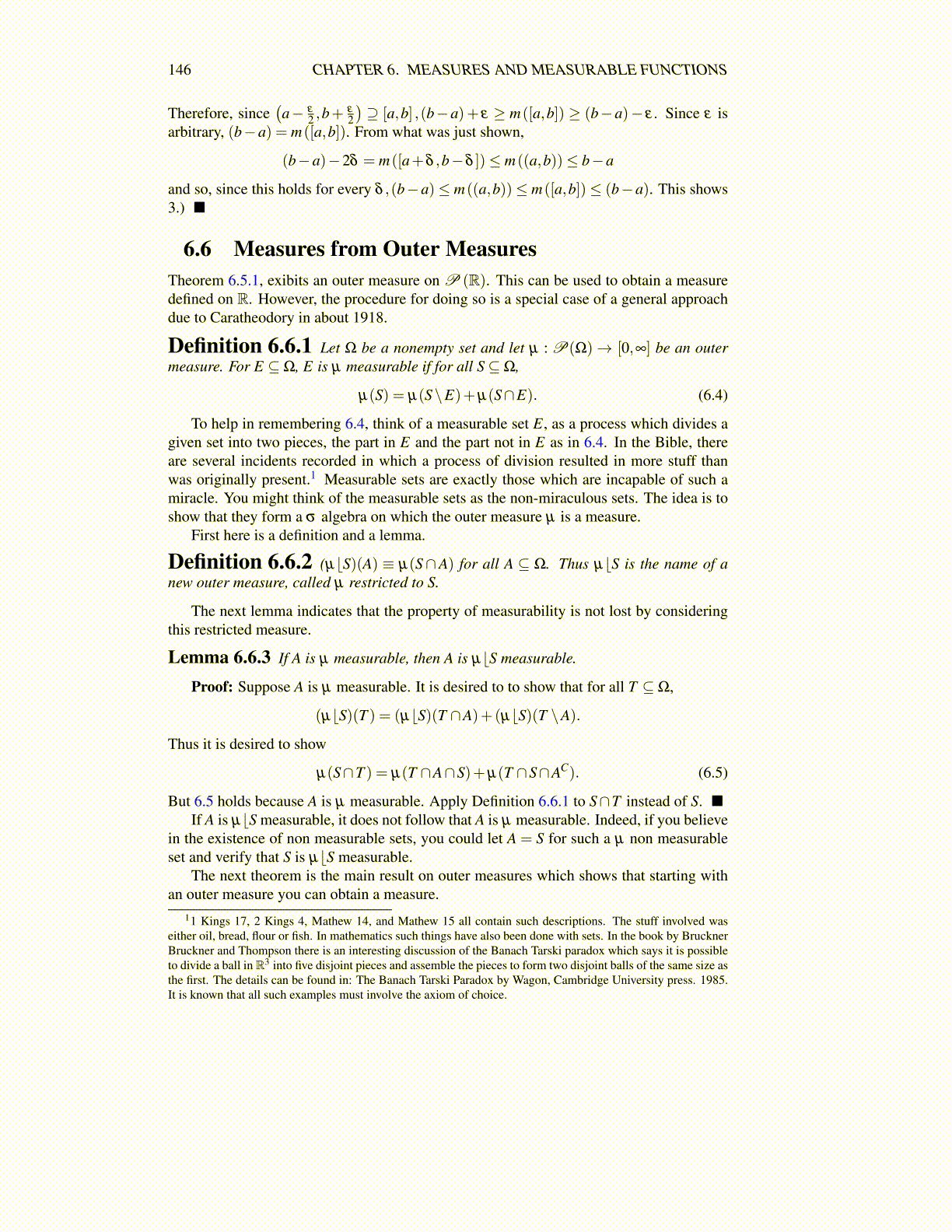
146 CHAPTER 6. MEASURES AND MEASURABLE FUNCTIONS
Therefore, since(a− ε
2 ,b+ε
2
)⊇ [a,b] ,(b−a)+ ε ≥ m([a,b]) ≥ (b−a)− ε . Since ε is
arbitrary, (b−a) = m([a,b]). From what was just shown,
(b−a)−2δ = m([a+δ ,b−δ ])≤ m((a,b))≤ b−a
and so, since this holds for every δ ,(b−a)≤ m((a,b))≤ m([a,b])≤ (b−a). This shows3.) ■
6.6 Measures from Outer MeasuresTheorem 6.5.1, exibits an outer measure on P (R). This can be used to obtain a measuredefined on R. However, the procedure for doing so is a special case of a general approachdue to Caratheodory in about 1918.
Definition 6.6.1 Let Ω be a nonempty set and let µ : P(Ω)→ [0,∞] be an outermeasure. For E ⊆Ω, E is µ measurable if for all S⊆Ω,
µ(S) = µ(S\E)+µ(S∩E). (6.4)
To help in remembering 6.4, think of a measurable set E, as a process which divides agiven set into two pieces, the part in E and the part not in E as in 6.4. In the Bible, thereare several incidents recorded in which a process of division resulted in more stuff thanwas originally present.1 Measurable sets are exactly those which are incapable of such amiracle. You might think of the measurable sets as the non-miraculous sets. The idea is toshow that they form a σ algebra on which the outer measure µ is a measure.
First here is a definition and a lemma.
Definition 6.6.2 (µ⌊S)(A) ≡ µ(S∩A) for all A ⊆ Ω. Thus µ⌊S is the name of anew outer measure, called µ restricted to S.
The next lemma indicates that the property of measurability is not lost by consideringthis restricted measure.
Lemma 6.6.3 If A is µ measurable, then A is µ⌊S measurable.
Proof: Suppose A is µ measurable. It is desired to to show that for all T ⊆Ω,
(µ⌊S)(T ) = (µ⌊S)(T ∩A)+(µ⌊S)(T \A).
Thus it is desired to show
µ(S∩T ) = µ(T ∩A∩S)+µ(T ∩S∩AC). (6.5)
But 6.5 holds because A is µ measurable. Apply Definition 6.6.1 to S∩T instead of S. ■If A is µ⌊S measurable, it does not follow that A is µ measurable. Indeed, if you believe
in the existence of non measurable sets, you could let A = S for such a µ non measurableset and verify that S is µ⌊S measurable.
The next theorem is the main result on outer measures which shows that starting withan outer measure you can obtain a measure.
11 Kings 17, 2 Kings 4, Mathew 14, and Mathew 15 all contain such descriptions. The stuff involved waseither oil, bread, flour or fish. In mathematics such things have also been done with sets. In the book by BrucknerBruckner and Thompson there is an interesting discussion of the Banach Tarski paradox which says it is possibleto divide a ball in R3 into five disjoint pieces and assemble the pieces to form two disjoint balls of the same size asthe first. The details can be found in: The Banach Tarski Paradox by Wagon, Cambridge University press. 1985.It is known that all such examples must involve the axiom of choice.